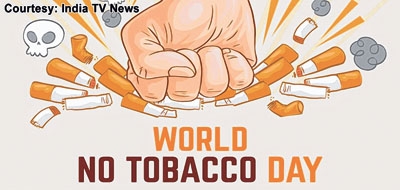Candy flavoured traps to hook the next generation
01 Jun 2024 00:47:43

Shobha Shukla (CNS)
Young people are using e-cigarettes at rates higher than adults in many countries, as the tobacco industry is specifically targeting youth, says The World Health Organization (WHO).
"History is repeating, as the tobacco industry tries to sell the same nicotine to our children in different packaging. These industries are actively targeting schools, children and young people with new products that are essentially a candy-flavoured trap. How can they talk about 'harm reduction' when they are marketing these dangerous, highly addictive products to children?," said Dr Tedros Adhanom Ghebreyesus, Director-General of the WHO.
This year’s theme for World No Tobacco Day - ‘Protecting children from tobacco industry interference’- advocates for an end to the targeting of youth with harmful tobacco products. The tobacco industry markets fruit and candy flavoured tobacco and nicotine products like gadgets or toys in attractive packaging under the garb of less harmful novel products. In reality, these products are hooking young people across the world to a life time of dangerous addiction.
“Hooking the next generation”, a new report jointly launched by WHO and STOP, a global tobacco industry watchdog, highlights how the tobacco industry designs products, implements marketing campaigns and influences policies to help addict the youth to tobacco. According to 2022 data, globally, an estimated 37 million children aged 13–15 years use some form of tobacco, and in many countries, the rate of e-cigarette use among adolescents exceeds that of adults. 85% of 15–30-year-olds are exposed to e-cigarette advertising across multiple media platforms, and that higher rates of exposure were linked to higher rates of e-cigarette use.
In the WHO European Region 4 million 13–15 years old- 11.5% of boys and 10.1% of girls - are tobacco users. Electronic cigarettes and nicotine pouches are gaining popularity among youth. An estimated 12.5% of adolescents in this used e-cigarettes in 2022 compared to 2% of adults. In some countries of the Region, the rates of e-cigarette use among school children are 2–3 times higher than the rates of cigarette smoking.
It is a well known fact that tobacco kills half of its users prematurely. In India nearly 3600 people die every day due to tobacco use. To find replacement consumers and generate a lifetime of profits, the tobacco industry is targeting the young generation.
India’s Global Youth Tobacco Survey 2019 found that the prevalence of tobacco among school going children aged between 13-15 years was 8.4%. The survey findings also show that even before celebrating their seventh birthday, 11.4% children start smoking cigarettes, 17.2% starting smoking bidis (hand rolled cheap cigarettes) and 24% start using smokeless tobacco products. India has taken comprehensive measures to reduce tobacco use including prohibition of e-cigarettes. WHO has supported the Indian Ministry of Health and Family Welfare in setting up an online platform to report violations related to the sale and advertisement of e-cigarettes.
“The industry uses sleek marketing campaigns with new media tools and harmless looking products designed to appeal to young people, thus creating a new wave of addiction. On World No tobacco Day this year, WHO Country Office for India is launching an awareness campaign exposing industry tactics to hook a new generation of users,” said WHO Representative to India Dr Roderico H. Ofrin.
At the recently held ASEAN Workshop on Protecting Children from Tobacco Industry Interference government officials, health advocates, and youth leaders reiterated the need to collaborate towards protecting children and youth from tobacco industry tactics. In Asia and globally, the uptake of electronic smoking devices (ESDs) by young people is increasing rapidly. In Malaysia, the prevalence of e-cigarette use among teenagers (13-15 years old) is 23.5% for boys and 6.2% for girls (2022). In Thailand, 20.2% of boys and 15% of girls were using ESDs in 2022.
Making false claims that ESDs can help smokers quit smoking cigarettes, the industry makes these newer products available in more than 16,000 flavours, most of which are candy and fruit flavors, and promotes them online to lure young people into a lifetime of nicotine addiction. “The tobacco industry will stop at nothing to ensure that its addictive and harmful business survives and thrives. Our children are under attack,” stated Professor (Dr) Prakit Vathesatogkit, Executive Director, Action on Smoking and Health, Thailand.
As per the 7th edition of the tobacco atlas global progress on tobacco endgame is threatened by growing smoking rates among children age 13 to 15 years in many countries and by tobacco industry tactics such as targeting poorer countries with weak regulatory environments and pushing novel products in previously untapped markets. Youth tobacco use (girls and/or boys) has increased in 63 of 135 countries surveyed. In several of these countries, including Haiti and Mauritania, tobacco use among adolescent girls is now more common than among adult women, indicating that the historically lower tobacco use among females worldwide may not continue in the near future.
World No Tobacco Day 2024 calls upon the governments and tobacco control community to protect current and future generations and to hold the tobacco industry liable for the harm it causes. May every day be a no tobacco day for all.
(Shobha Shukla is the award-winning founding Managing Editor and Executive Director of CNS (Citizen News Service) and is a feminist, health and development justice advocate. She is a former senior Physics faculty of Loreto Convent College and current Coordinator of Asia Pacific Regional Media Alliance for Health and Development (APCAT Media) and Global AMR Media Alliance (GAMA).